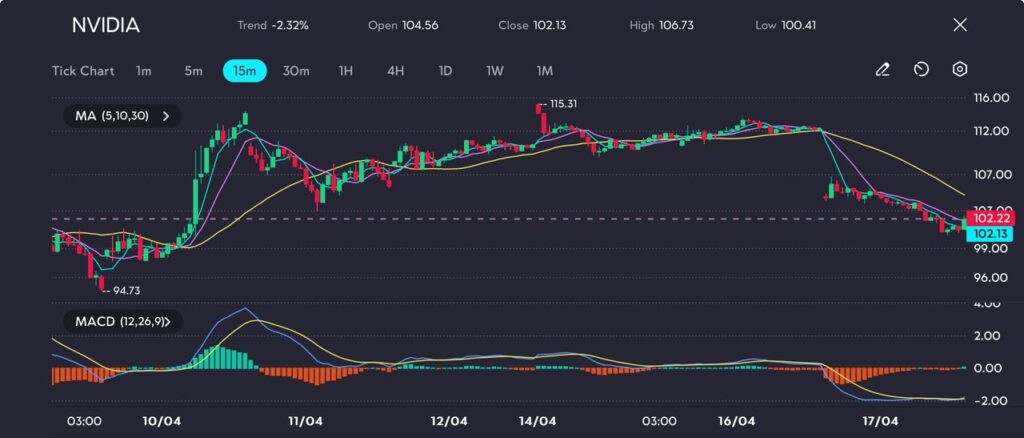
Key Points
- Nvidia (NVDIA) closes at $102.13, down 2.32%, from a session high of $106.73.
- Company warns of $5.5 billion hit due to U.S. restrictions on AI chip sales to China.
- MACD bearish crossover and price action below key moving averages suggest further downside risk.
Nvidia shares extended losses on Thursday, closing at $102.13, down 2.32%, as the market continued to digest the company’s stark guidance revision stemming from new U.S. restrictions on chip exports to China. This comes after Nvidia disclosed it expects to lose as much as $5.5 billion in revenue in its fiscal first quarter due to the limitations imposed on its China-focused AI processors.
The news hit the broader semiconductor sector hard, with peer ASML also warning that Trump’s tariff policy is creating uncertainty for 2025–2026. ASML shares dropped over 6%, and the pressure has cascaded across global chip names. TSMC’s upcoming earnings will now be heavily scrutinised as a barometer for the industry’s health, especially as cyclical risks resurface amid mounting global trade tensions.
In the U.S., Fed Chair Jerome Powell added further caution to the tone, stating that tariffs could simultaneously slow growth and fuel inflation—putting the Fed in a “rock and hard place” scenario. Despite Powell’s dovish hints, investors remain wary of stagflation risks—a scenario historically unfavourable to growth stocks, particularly high-beta names like Nvidia.
Technical Analysis
The 15-minute chart of NVIDIA displays a clear shift in momentum, signaling a potential short-term correction after an extended rally. Following a sharp breakout from the 94.73 low, the stock surged aggressively to peak at 115.31, forming a potential swing high. Since then, the price has gradually pulled back, breaking below short-term moving averages and now resting near 102.13 at close.

Picture: Bearish crossover on MACD adds weight to NVIDIA’s descending trend, as seen on the VT Markets app
The MACD indicator confirms the bearish shift: the MACD line has crossed below the signal line, and the histogram has remained in negative territory, showing persistent downward pressure. This bearish crossover, paired with a widening gap between the 5, 10, and 30-period moving averages, reflects growing selling interest and fading bullish momentum.
Price is currently hovering just above a critical support zone near the 100–101 range. If this level fails to hold, further downside toward the 98–99 handle may unfold, particularly if broader market sentiment remains risk-off. However, any rebound would need to reclaim the 105–106 range to negate this short-term bearish bias.
Cautious Outlook for Nvidia
With prices below the 30-period moving average and weakening technicals, Nvidia could retest the $100–$98 zone unless there’s a sentiment shift from TSMC’s earnings or trade policy easing. Near-term resistance stands at $106–$107, but a recovery toward $110+ looks unlikely without a meaningful catalyst.









